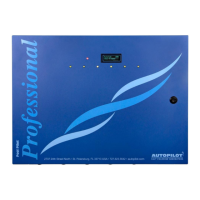Page - 26
Circular
l Area = Radius x Radius x 3.14
l Gallons = area x average depth (ft
3
) x 7.5
l Liters = area x average depth (m
3
) x 1,000
To determine the approximate number of gallons or liters in a more complex shaped pool:
1.
Divide the complex shape into several simple shapes.
2.
Calculate each one separately, and then add back together.
Example: An oblong pool can be divided into two radius measurements and one
rectangular shape. (R = Radius)
l Area = Radius x Radius x 3.14 + (Length x Width)
l Gallons = area x average depth (ft
3
) x 7.5
l Liters = area x average depth (m
3
) x 1,000
8.6.b Steps to Prepare Water
1.
Calculate pool volume.
2. Add salt to water (test the water for salt level first). Adjust to 3,500 – 4,500 ppm (mg/L). See "Salt
Addition Chart" on page 40.
3.
Balance pool water. Add chemicals to adjust pool or spa water chemistry parameters as indicated.
See "Water Balance and Chemistry Recommendations" on page 4. See "Using the Saturation Index"
on page 39. If the saturation index indicates that the pool water is corrosive or scaling, then
adjustments to the water chemistry should be made.
4.
Add initial chlorine dosage. Use sufficient chlorine as obtained from pool supply center to achieve 1-3
ppm (mg/L), or local commercial guidelines, of free chlorine.
5. Enter pool volume information into the chlorinator. See "Set Pool Volume" on page 21.
8.6.c Adding Salt
Type of Salt to Add
It is important to use Sodium Chloride (NaCl) salt that is greater than 99% pure. Acceptable
types of salt include granular food grade, pool salt, water softener pellets, or solar salt flakes;
these are usually available in 25 to 60 lb bags (11 to 27 kg) at local pool or building supply
outlets. Pool salt or food grade granular salt will dissolve faster than pellets or flakes. Rock salt
and Granular Salt with Iodine or Rust Preventatives should not be used, as these mixtures
contain high levels of impurities and will cause staining. Granular salts containing anti-caking
additives such as YPS (Yellow Prussiate of Soda) or sodium ferrocyanide are not recommended
as they can cause a localized tint to the water or yellow staining of the pool / spa finish.
Amount of Salt Required
Test the water for current salt content first!
The ideal salt range is 3,500 – 4,500 ppm (mg/L). The minimum salt level is 2,500 ppm (mg/L).
However, if so desired, the Pool Pilot
®
can operate with salt levels in excess of 35,000 ppm
(mg/L). Salt levels above 6,000 ppm (mg/L) are not normally recommended as corrosion issues
may result. Salt levels below 2,500 ppm (mg/L) will reduce the efficiency of the Pool Pilot
®
, and
will result in low chlorine production. Extremely low salt levels below 1,900 ppm (mg/L) will
activate the low salt safety cut off and will halt chlorine production until salt is replenished to
proper levels.

